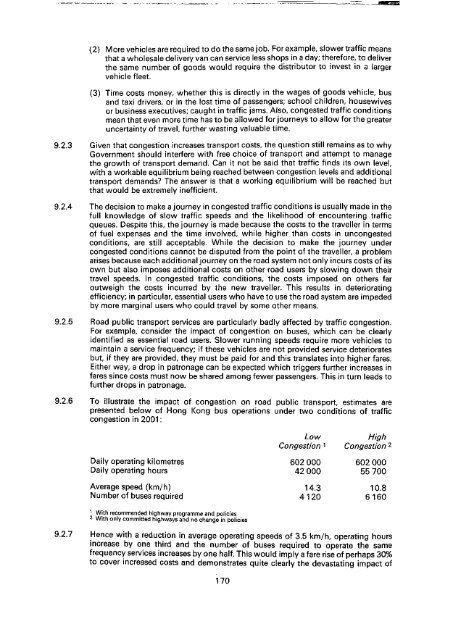Untitled - HKU Libraries - The University of Hong Kong
Untitled - HKU Libraries - The University of Hong Kong
Untitled - HKU Libraries - The University of Hong Kong
- No tags were found...
Create successful ePaper yourself
Turn your PDF publications into a flip-book with our unique Google optimized e-Paper software.
(2) More vehicles are required to do the same job. For example, slower traffic meansthat a wholesale delivery van can service less shops in a day; therefore, to deliverthe same number <strong>of</strong> goods would require the distributor to invest in a largervehicle fleet.(3) Time costs money, whether this is directly in the wages <strong>of</strong> goods vehicle, busand taxi drivers, or in the lost time <strong>of</strong> passengers; school children, housewivesor business executives; caught in traffic jams. Also, congested traffic conditionsmean that even more time has to be allowed for journeys to allow for the greateruncertainty <strong>of</strong> travel, further wasting valuable time.9.2.3 Given that congestion increases transport costs, the question still remains as to whyGovernment should interfere with free choice <strong>of</strong> transport and attempt to managethe growth <strong>of</strong> transport demand. Can it not be said that traffic finds its own level,with a workable equilibrium being reached between congestion levels and additionaltransport demands? <strong>The</strong> answer is that a working equilibrium will be reached butthat would be extremely inefficient.9.2.4 <strong>The</strong> decision to make a journey in congested traffic conditions is usually made in thefull knowledge <strong>of</strong> slow traffic speeds and the likelihood <strong>of</strong> encountering trafficqueues. Despite this, the journey is made because the costs to the traveller in terms<strong>of</strong> fuel expenses and the time involved, while higher than costs in uncongestedconditions, are still acceptable. While the decision to make the journey undercongested conditions cannot be disputed from the point <strong>of</strong> the traveller, a problemarises because each additional journey on the road system not only incurs costs <strong>of</strong> itsown but also imposes additional costs on other road users by slowing down theirtravel speeds. In congested traffic conditions, the costs imposed on others faroutweigh the costs incurred by the new traveller. This results in deterioratingefficiency; in particular, essential users who have to use the road system are impededby more marginal users who could travel by some other means.9.2.5 Road public transport services are particularly badly affected by traffic congestion.For example, consider the impact <strong>of</strong> congestion on buses, which can be clearlyidentified as essential road users. Slower running speeds require more vehicles tomaintain a service frequency; if these vehicles are not provided service deterioratesbut, if they are provided, they must be paid for and this translates into higher fares.Either way, a drop in patronage can be expected which triggers further increases infares since costs must now be shared among fewer passengers. This in turn leads t<strong>of</strong>urther drops in patronage.9.2.6 To illustrate the impact <strong>of</strong> congestion on road public transport, estimates arepresented below <strong>of</strong> <strong>Hong</strong> <strong>Kong</strong> bus operations under two conditions <strong>of</strong> trafficcongestion in 2001:LowHighCongestion 1 Congestion 2Daily operating kilometres 602 000 602 000Daily operating hours 42 000 55 700Average speed (km/h) 14.3 10.8Number <strong>of</strong> buses required 4120 61601 With recommended highway programme and policies2 With only committed highways and no change in policies9.2.7 Hence with a reduction in average operating speeds <strong>of</strong> 3.5 km/h, operating hoursincrease by one third and the number <strong>of</strong> buses required to operate the samefrequency services increases by one half. This would imply a fare rise <strong>of</strong> perhaps 30%to cover increased costs and demonstrates quite clearly the devastating impact <strong>of</strong>170
















